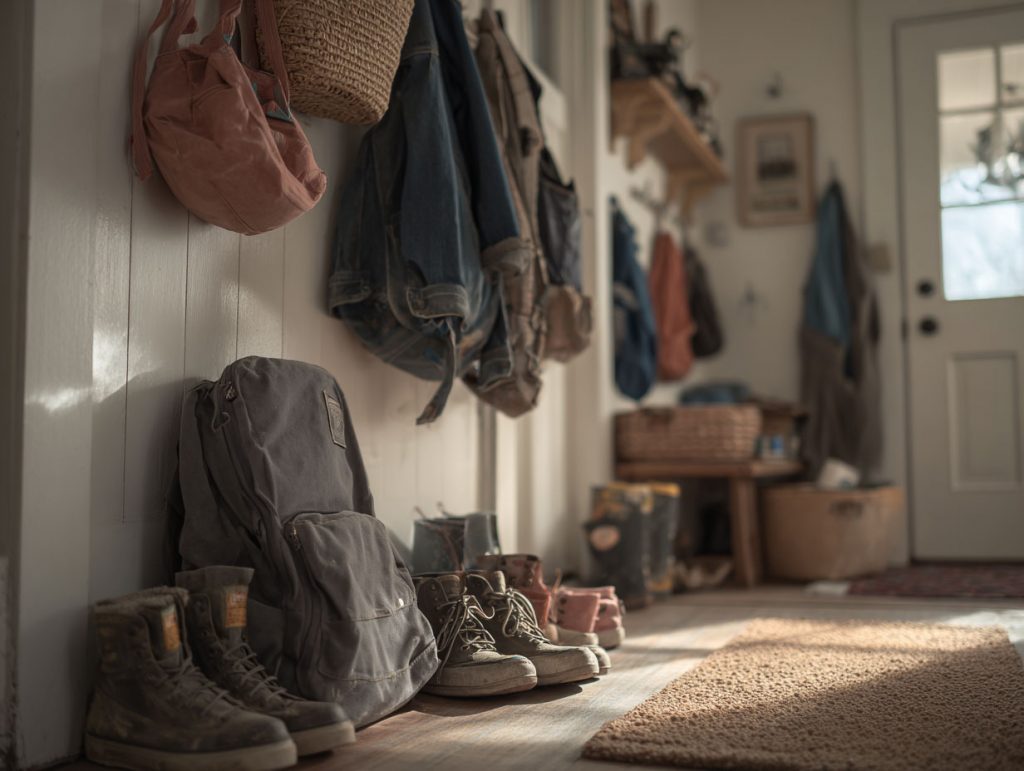
If you want to understand a family’s daily rhythm, look at the hallway.
Not the kitchen. Not the living room. The hallway.
It’s the launchpad, the landing zone, the checkpoint, and sometimes the aftermath of—well—everything.
In Destin homes, the hallway carries evidence of:
- school drop-offs
- sports practice
- work rush hours
- dog walks
- grocery runs
- beach detours that “won’t bring sand inside” (spoiler: they always do)
And unlike other rooms, the hallway doesn’t get moments of calm.
It’s transition territory. A physical loading screen between life activities.
Why hallways collapse faster than any other space
Because they serve four different roles without asking permission:
- Storage – shoes, bags, jackets, keys, mail, coffee cups mid-journey
- Traffic – constant movement means nothing gets “finished” there
- Drop zone – if hands are full, it lands here
- Undefined space – no rules, no system, no borders
Most homes organize every room except the hallway.
But the hallway organizes your peace of mind.
The common hallway disaster pattern
It usually evolves like this:
- A pair of shoes appears
- Shoes invite more shoes
- A backpack joins in
- Mail lands nearby
- Someone drops a hoodie
- A beach towel shows up uninvited
- Sand enters like it pays rent
- Suddenly the hallway becomes an obstacle course
What started as two shoes becomes a lifestyle.
The main problem isn’t clutter… it’s speed
The hallway doesn’t get messy because families don’t care.
It gets messy because nobody pauses long enough to finish the action:
- Shoes are removed but not parked
- Jackets are dropped but not hung
- Mail is delivered but not decided
- Bags are placed but not emptied
The hallway receives, but nobody ever closes the cycle.
The invisible stress effect
A messy hallway creates morning and evening friction:
- “Has anyone seen my other shoe?”
- “Who took my backpack?”
- “Why are there 14 jackets here?”
- “Where did the important envelope go?”
- “Why is the floor… gritty?”
The hallway is the stage where small frustrations become loud conversations.
Why traditional solutions don’t stick
| Attempted fix | Why it fails |
|---|---|
| Shoe racks | Too small, too slow, too organized |
| Hooks | Great until there are more items than hooks |
| Baskets | Become archaeological storage |
| Rules | Families are fast, rules are slow |
| Minimalism | Hard to maintain with real children |
The issue isn’t capacity.
It’s friction.
If the system takes longer than dropping the item, the system loses.
Hallway success has nothing to do with style
You don’t need:
- matching baskets
- perfect labels
- aesthetic symmetry
You need:
- speed
- visibility
- zero decisions
- muscle memory
A hallway works when people can reset it without thinking.
If your hallway could talk, it would scream “I’m not the problem — I’m the symptom!”
By Part 1, we already know: hallways fail not because families are messy, but because the system is slow. Now it’s time to fix it with methods that are faster than the chaos itself.
Our goal isn’t perfection — it’s flow, speed, and zero decision-making.
The 3-Second Rule (The only hallway rule that matters)
Every item entering the hallway must be:
- placed in 3 seconds or less
- without opening anything
- without moving another item
- without thinking
If the system takes 4 seconds, you’ve already lost to gravity and chaos.
Examples:
- Drop shoes into a tray = 1 second
- Hang a jacket on the first hook you see = 2 seconds
- Toss mail into the inbox bin = 1 second
If there’s a lid, drawer, latch, stack, or sorting process, the system will fail by Tuesday.
The Real Hallway Setup (No Pinterest Required)
You only need 5 functional stations:
- Shoe landing zone (no racks, just trays or open floor borders)
- Bag & jacket hooks (at kid + adult height)
- The “inbox” basket (mail, papers, receipts, mystery items)
- Sand defense zone (mat + tiny handheld sweeper or brush nearby)
- Exit-ready shelf (keys, wallets, dog leash, sunglasses, permission slips)
Notice what’s missing: folding, sorting, organizing, labeling marathons.
Shoes: The root of 60% of hallway crimes
Shoe racks are slow.
Kids shove shoes, adults align shoes, and nobody wins.
Replace shelves with:
- A low tray
- A mat with edges
- A marked floor zone
Goal: shoes land, not park.
Bonus hack:
If the shoes don’t fit in the zone, no more shoes are allowed to live there. Natural boundary control beats arguments.
The Mail System That Actually Works
Forget sorting mail by category. Sort by urgency:
- SPOT A: Open in 10 seconds or less
- SPOT B: Needs attention this week
- SPOT C: “Future me problem”
One basket split into 3 sections or 3 mini trays. Done.
If mail piles last more than 48 hours, they become decor.
Sand Management Without Losing Your Mind
You live near the beach. Sand is not the enemy — sand is a seasonal pet.
Instead of fighting it hourly:
- Add a textured door mat inside AND outside
- Place a handheld brush or mini sweeper within reach
- Make it easier to sweep sand than complain about it
If cleaning the sand requires going to another room for a tool, sand wins.
The 90-Second Night Reset
This is the moment the magic happens.
Before bed, anyone passing through the hallway must do one micro-task:
- Sweep shoes into the zone (10 sec)
- Hang any item on a hook (5 sec)
- Put 3 things in the inbox basket (10 sec)
- Quick sand brush swipe (15 sec)
- Floor check — nothing should require kneeling (10 sec)
Three people doing 30 seconds each = hallway peace restored.
No meetings. No negotiations. No drama.
What a winning hallway looks like
- You can walk without navigating
- Mornings start without scavenger hunts
- Shoes form a community, not a rebellion
- Sand is managed, not feared
- Exit items exit with humans, not after them
Not spotless.
Not styled.
Just working.
Read also: The Toy Explosion Theory: Why Kids’ Rooms Never Stay Clean (And Why It’s Not the Kids’ Fault)


